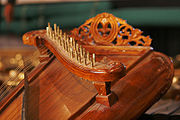Gamelan
 A gamelan is a kind of musical ensemble of Indonesia typically featuring a variety of instruments such as metallophones, xylophones, drums, and gongs; bamboo flutes, bowed and plucked strings, and vocalists may also be included. The term refers more to the set of instruments than the players of those instruments. A gamelan as a set of instruments is a distinct entity, built and tuned to stay together — instruments from different gamelan are not interchangeable. The word "gamelan" comes from the Javanese word "gamel", meaning to strike or hammer, and the suffix "an", which makes the root a collective noun.
A gamelan is a kind of musical ensemble of Indonesia typically featuring a variety of instruments such as metallophones, xylophones, drums, and gongs; bamboo flutes, bowed and plucked strings, and vocalists may also be included. The term refers more to the set of instruments than the players of those instruments. A gamelan as a set of instruments is a distinct entity, built and tuned to stay together — instruments from different gamelan are not interchangeable. The word "gamelan" comes from the Javanese word "gamel", meaning to strike or hammer, and the suffix "an", which makes the root a collective noun.Instruments and characteristics
 Gamelan are found in the Indonesian islands of Java, Madura, Bali, and Lombok (and other Sunda Islands), in a wide variety of ensemble sizes and formations. In Bali and Lombok today, and in Java through the 18th century, the term "gong" has been preferred to or synonymous with gamelan. Traditions of gamelan-like ensembles (a well known example of which is Kulintang, sometimes called "gong-chime ensembles" by ethnomusicologists) also exist in the Philippines, Malaysia and Suriname, sometimes due to emigration, historic trade, or diplomacy. More recently, through immigration and local enthusiasm, gamelan ensembles have become active throughout Europe, The Americas, Asia, and Australia.
Gamelan are found in the Indonesian islands of Java, Madura, Bali, and Lombok (and other Sunda Islands), in a wide variety of ensemble sizes and formations. In Bali and Lombok today, and in Java through the 18th century, the term "gong" has been preferred to or synonymous with gamelan. Traditions of gamelan-like ensembles (a well known example of which is Kulintang, sometimes called "gong-chime ensembles" by ethnomusicologists) also exist in the Philippines, Malaysia and Suriname, sometimes due to emigration, historic trade, or diplomacy. More recently, through immigration and local enthusiasm, gamelan ensembles have become active throughout Europe, The Americas, Asia, and Australia.Although gamelan ensembles sometimes include solo and choral voices, plucked and/or bowed string and wind instruments, they are most notable for the large number of metal percussion instruments. The percussion instruments of a central Javanese gamelan ensemble include:
- metallophones, such as the saron, gendér, gangsa, and ugal (sets of metals bars laid out in a single row and struck like a glockenspiel)
- cradled gong chimes called bonang and kenong (sets of large, drum-shaped gongs laid out horizontally on stands)
- hanging gongs called kempul and the large gong ageng
- xylophone-like instruments called gambang (similar to saron and gendér but with wooden bars instead of metal ones)
- drums called kendhang
Metals used include bronze, brass, and iron, with a 10:3 copper-to-tin bronze alloy usually considered the best material. In addition, there are gamelan ensembles composed entirely of bamboo-keyed instruments, of bamboo flutes, of zithers, or of unaccompanied voices with the functions of metallophones or gongs in the metal ensemble transferred to surrogates.
Gamelan music is built up in layers. At its centre is a basic melody (core melody) known as the balungan. Further layers, including singing in vocal pieces, elaborate upon this melody in certain ways, but the notes of each layer of music relate to the balungan, and generally coincide at the ends of phrases (called seleh in Javanese). There are also a set of instruments which delineate a colotomic structure, usually ending in the stroke of the largest gong.
Tuning

The tuning and construction of a gamelan orchestra is a complex process. Javanese gamelans use two tuning systems: sléndro and pélog. There are other tuning systems such as degung (exclusive to Sunda, or West Java), and madenda (also known as diatonis, similar to a European natural minor scale). In central Javanese gamelan, sléndro is a system with five notes to the diapason (octave), fairly evenly spaced, while pélog has seven notes to the octave, with uneven intervals, usually played in five note subsets of the seven-tone collection. This results in sound quite different from music played in a western tuning system. Many gamelan orchestras will include instruments in each tuning, but each individual instrument will only be able to play notes in one. The precise tuning used differs from ensemble to ensemble, and give each ensemble its own particular flavour. The intervals between notes in a scale are very close to identical for different instruments within each gamelan, but the intervals vary from one gamelan to the next.
Colin McPhee remarked, "Deviations in what is considered the same scale are so large that one might with reason state that there are as many scales as there are gamelans."[10] However, this view is contested by some teachers of gamelan, and there have been efforts to combine multiple ensembles and tuning structures into one gamelan to ease transportation at festival time. One such ensemble is gamelan Manikasanti, which can play the repertoire of many different ensembles.
Balinese gamelan instruments are commonly played in pairs which are tuned slightly apart to produce interference beats, ideally at a consistent speed for all pairs of notes in all registers. It is thought that this contributes to the very "busy" and "shimmering" sound of gamelan ensembles. In the religious ceremonies that contain gamelan, these interference beats are meant to give the listener a feeling of a god's presence or a stepping stone to a meditative state.
Labels: majaradjasa



0 Comments:
Post a Comment
Subscribe to Post Comments [Atom]
<< Home